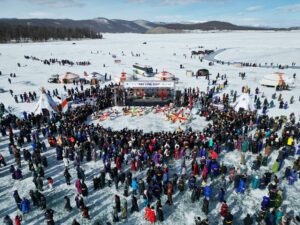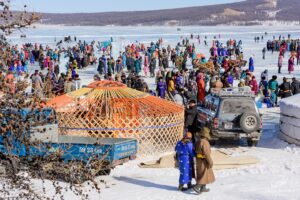From ancient times the wedding was an important ceremony for Mongols which represents the auspicial to newly married bride and groom. In the past wedding ceremony was strictly regulated and had norms to must follow. For instance, a wedding ceremony should start very specific time and even there was certain songs that can not be sung. Young women who have not married and live with their parents will braid the hair into 24 parts while married women’s braiding will be only divided into 2 main parts. There are several braiding methods for married women and unmarried women to represent their marital status by their braiding.
Wedding customs are vary depending on the region and ethnicity thus we would like to introduce the most widely accepted customs.
Engagement gift
The bride’s side will expect an engagement gift from the groom’s side as validation of the marriage. Central and western region Khalkh (dominant ethnicity in Mongolia) groom’s side will present odd-numbered herd 5, 7 or 9, a number of the herd would be decided by bride’s side. The number of the engagement herd depends on the wealth of the groom’s side.
Engagement gifts could be included glue as a symbol of together in harmony, rasp as a symbol of obliteration of obstacles, and silicon as a symbol of ignition of fire (fire symbolizes eternity, growth, wealth, and success).
Ceremony of asking for a bride’s hand in a marriage
On engagement day both sides will have a small feast together and schedule a specific day to begin to live together. Usually, it scheduled day would be within 3 to 6 months after engagement day. The period of postponing will be 3-6 months. The extension period is a test for the young couple.
Before the wedding of young couples, ger has to be built and according to the tradition bride’s side have to prepare the furniture and groom’s side is responsible for preparation of the ger.
Wedding ceremony
At the beginning of the ceremony, the two bridesmaids accompanying brides-to-be have led her to father-in-law and placed on white felt on the southeast side of the ger. At this time, the bride is wrapped in a white cotton bag in both hands, a five-color silk rag, fat, and butter are offered into the fire, and the bride has to bow three times the front оpen fire trivet.
During the wedding, the groom has to ignite the fire and the bride has to make the tea and serve all the guests by herself. After that silver rings have to be exchanged and worn on the wedding finger. The first fire was lit by the bride meaning that “The fire was taken from my father’s trivet. We will carry this fire forever, and the exchange of rings will make us weld as one.”
From the day of the wedding within a month, the bride does not go to her father’s house. But the father returned to his daughter’s place three days later. A month later daughter is allowed to go to her father’s place when the daughter goes to her father’s house, she is a guest, and the husband sends back a gift as a token of her wife’s dowry.





